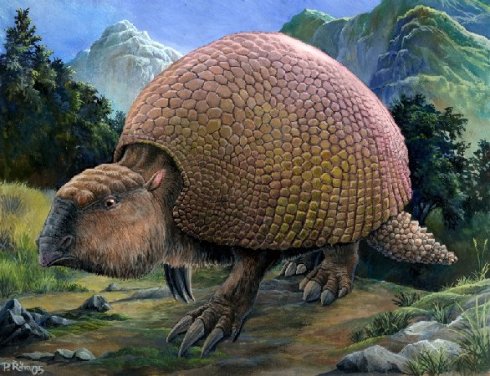We boldly continue armor week with an overview of the magnificent armadillo family. This order of armored mammals (Cingulata) is more diverse than any other sort of armored mammals–outshining even the scaled pangolins. Today the only living members of the Cingulata order are the armadillo family (a successful group consisting of more than 20 living species) but the armadillos’ extinct cousins were once far more widespread and bizarre. These relatives included the pampatheres–long plantigrade browsing creatures covered in banded armor who roamed the continent from one end to the other. Even more impressive were the glyptodonts, massive tank-like creatures bigger than a compact car.
The Cingulata order is part of the superorder Xenarthra. Separated from all other placental mammals for over 100 million years (due to South America’s unique isolation after the breakup of the southern supercontinent Gondwana), xenarthrans evolved in different directions from other mammals. The unique challenges and opportunities of their island continent resulted in bony domed giants like the pampatheres and glyptodonts, both of which are characterized by tortoise-like body armor composed of bone segments (osteoderms). The glyptodonts were unlike tortoises in that they could not draw their head beneath their shells: instead their heads were protected by bony caps atop their skulls. The largest glyptodonts could grow to 4 metres long, 1.5 metres high and have a mass of 3 tons (Ferrebeekeeper has already written about the smallest known Cingulata species—the pink fairy armadillo, which can still be found living in the central dry lands of Argentina).
Thanks to convergent evolution the herbivorous glyptodonts resembled other armored giants like cryptodire turtles and ankylosaurs. One species of glyptodont, Doedicurus clavicaudatus, even had a heavy spiked tail (although it is unclear whether this was used against predators or to compete for territory and mates).
When the first members of the Cingulata order emerged in the Myocene, the top predators of South America were giant running predatory birds–the Phorusrhacidae, which resembled giant dashing eagles up to 3.2 metres (10 ft) high. The glyptodonts, pampatheres, and armadillos outlasted these terror birds and they then outlasted the carnivorous metatherian mammals (with terrible saber teeth) which followed. When the Isthmus of Panama connected South America with North America (and therefore with an entirely new universe of ultra-competitive mammals), the armored cingulatans competed just fine with the newcomers. Some glyptodonts and pamphatheres wandered up through Central America and found new homes in North America. The armadillos are still there. However at the end of the last ice-age, a new African species arrived and brought a devastating and final end to the glyptodonts, the pampatheres, and most of the armadillos. But even this newly arrived predator seemed impressed by the greatest of armored mammals. An Argentine anthropologist even reports discovering a site twenty leagues from Buenos Aires where early human hunters had used glyptodont shells as dwelling places.






4 comments
Comments feed for this article
July 27, 2011 at 9:54 PM
stilltitled
sadly, these poor armored fellows have been recently besmirched with allegations of infection. You see, the leprosy bacteria found its vector in the most unlikely of hosts. The armadillo. What was once a lovable, if overly armored animal has now been found guilty of spreading most contemporary cases of leprosy in the American southwest.
July 28, 2011 at 9:47 AM
Hieronymo
This NY Times article attributes 1/3 of contemporary leprosy infections (in the United States) to armadillos and explains a little bit more about the disease.
Thanks for the good safety tip. Do not lick armadillos!
July 29, 2011 at 12:01 PM
esmeraldamac
Blimey! Question is, did humans copy animal armour, or is this just nature’s most practical way of protecting the body? Either way, I bemoan the loss of the giant armadillo. Although I don’t think I’d want one as a pet! (And, for that matter, I wasn’t planning on licking them…)
July 29, 2011 at 8:06 PM
Hieronymo
I miss the glyptodons too. The big shelly guys could probably really mess up a rose garden, but I suspect the world would be richer if the first Americans had left some of the giants that once lived here…